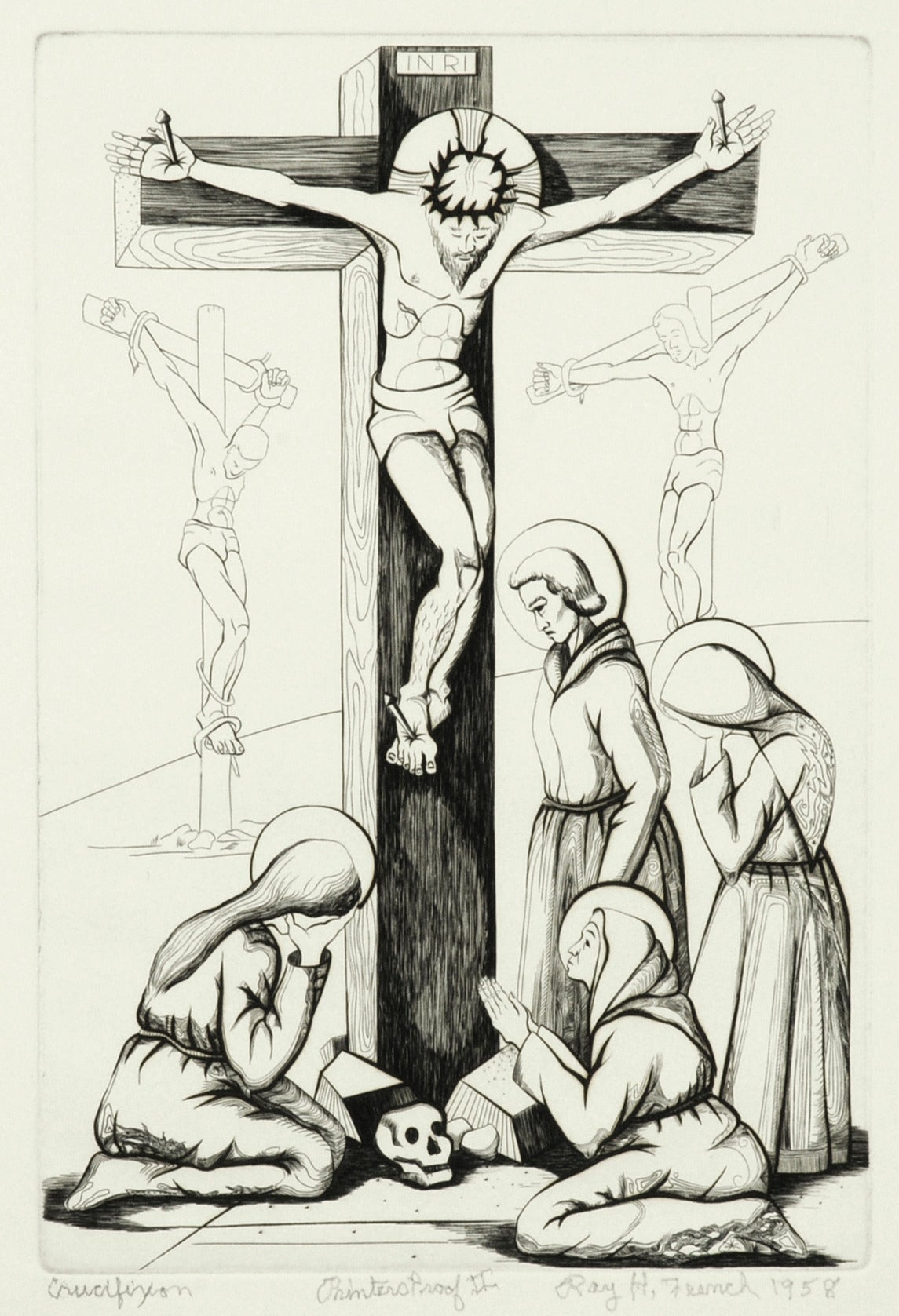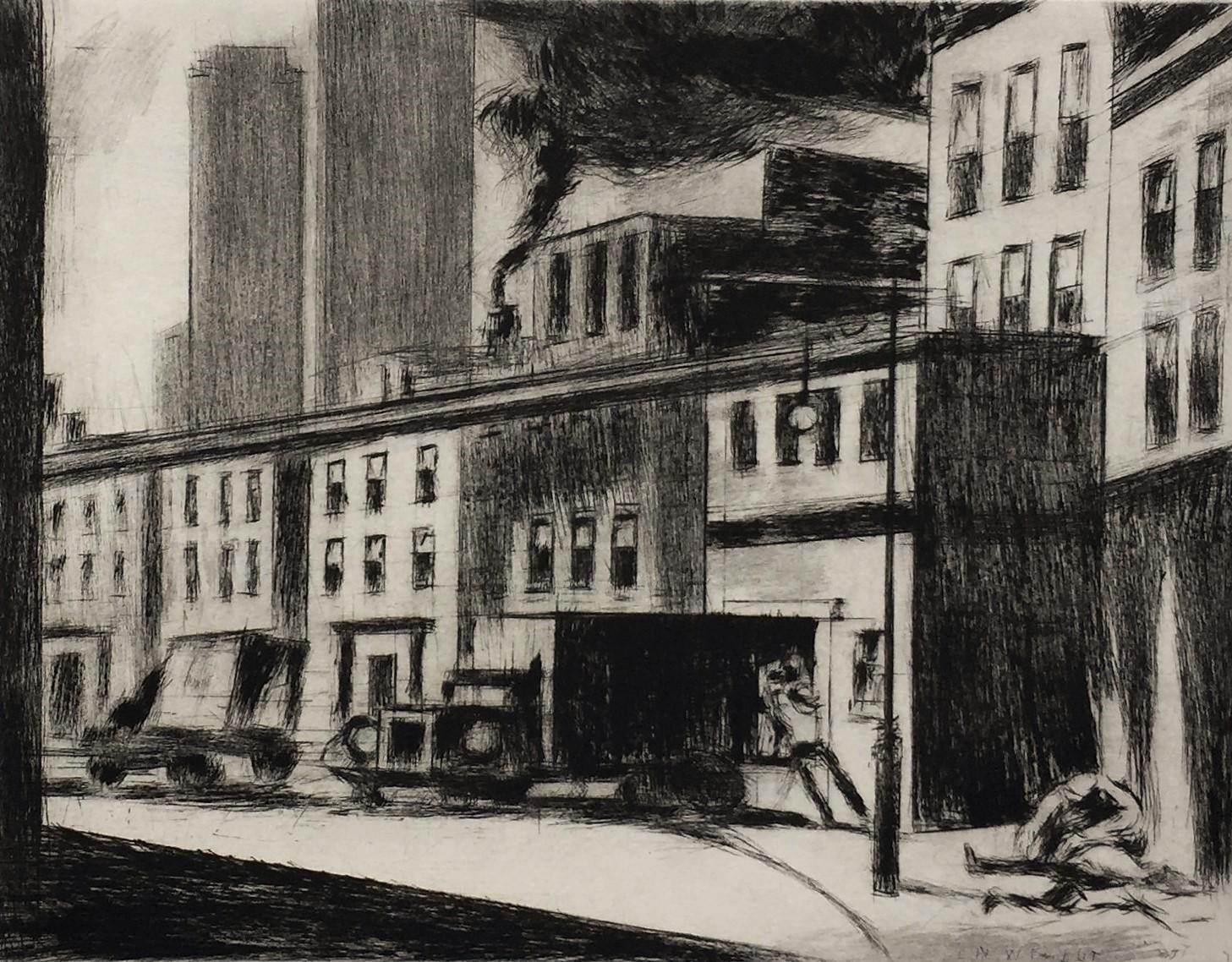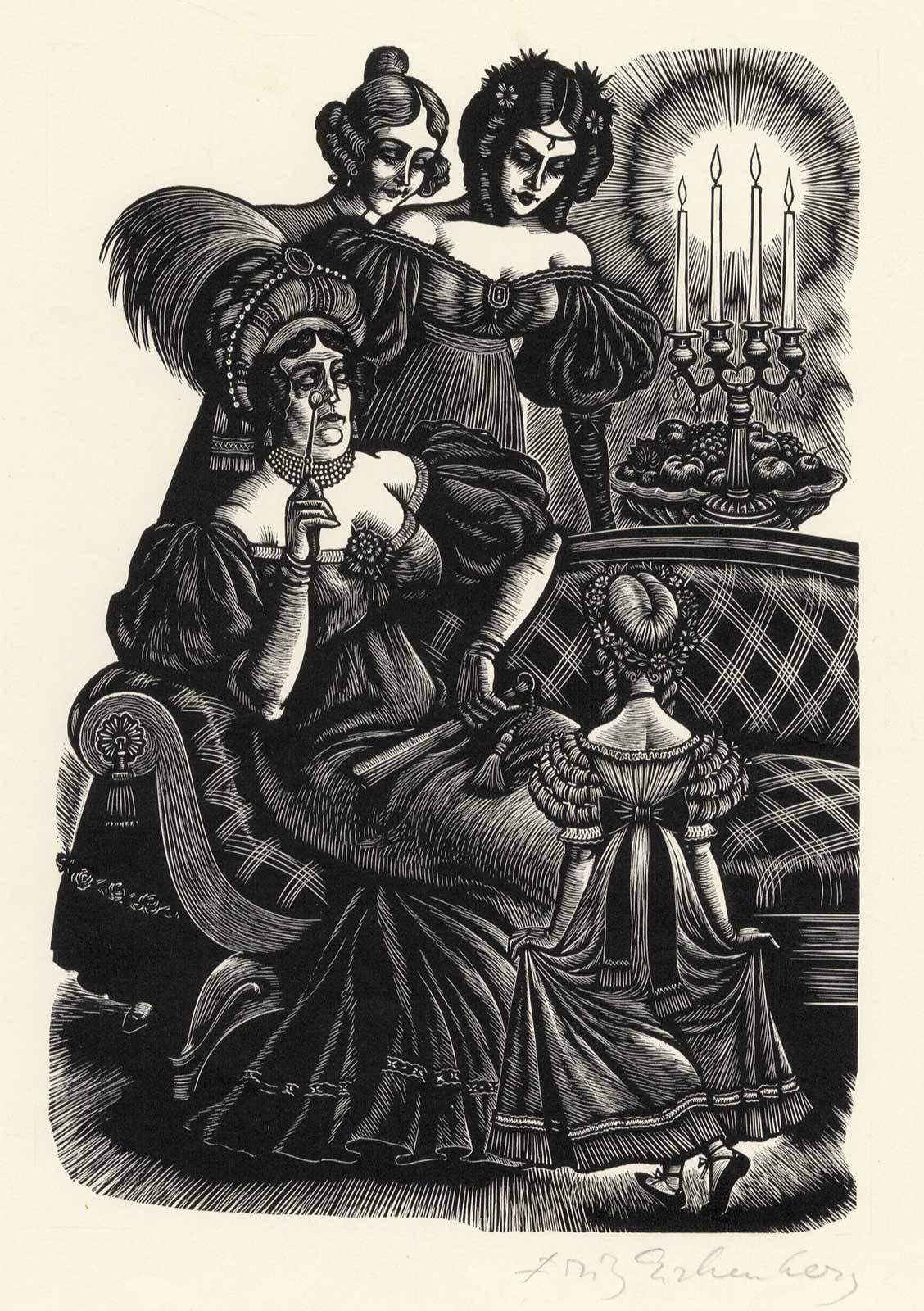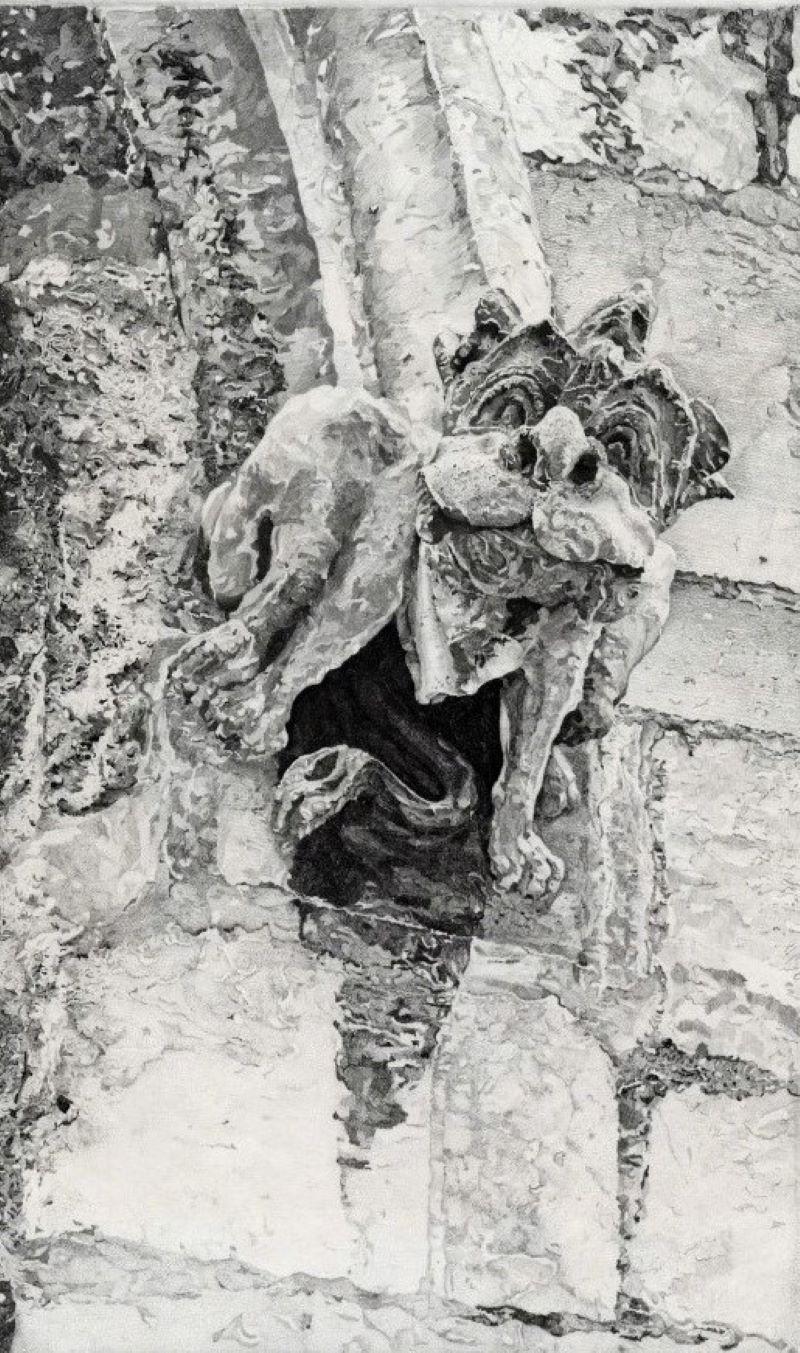Items Similar to Olympian Games
Want more images or videos?
Request additional images or videos from the seller
1 of 11
Ray H. FrenchOlympian Games1957
1957
About the Item
Olympian Games
Engraving, 1957
Signed, dated, titled and numbered (see photos)
Edition: 25 (7/25)
From the first and only edition, probably less than 8 impressions printed
Printed by the artist
Condition: Excellent
soft fold in upper left margin
Image size: 15 7/8 x 19 7/8 inches
Sheet size: 18 1/2 x 22 3/8 inches
Provenance: Estate of the artist
Martha A. French Revocable Trust
Item Reference
LU14013763732
Crucifixion, color etching, 1947
Item Reference
LU14013160582
The Web, engraving, 1950
Item Reference
LU14011892032
The Swan, mixed media (etching & soft ground), 1957
Item Reference
LU1404294651
Snowy Egret, engraving, 1954, third edition c. 1990, printed by the master printer Jon Clemens
Item Reference
LU1402253433
Debris, color etching, c. 1940, printed by the artist at the John Herron Art Institute, Indianapolis, Indiana
Item Reference
LU140331242
Crucifixion, engraving, 1958
Item Reference
LU140145330
Strange Animals, engraving, 1947
Item Reference
G130708140172
The Gull, engraving, 1955
Item Reference
LU14012448972
Moon Rays, graphic construction, 1967
Moon Rays
Graphic Construction (three sheets layered in a shadow box presentation), 1967
Signed lower right. Editioned lower left. (see photos)
Edition: 60 from the second printing c. 1990 (see photo)
Presented in a black wooden frame with a three level archival presentation with OP3 Acrylic
Frame size: 31 1/4 x 23 1/4 inches
In the 1960s, Ray also started to focus on blind embossing, which he had first experimented with at the University of Iowa. He was extremely prolific and successful with this medium, selling hundreds of prints in small editions of 10 through the Associated American Artist Gallery in New York. In 1966, Ray built upon his mastery of embossing and began developing a shadow box presentation called a graphic construction that combined color, blind embossing, and multi-layered cutouts to revel embossed intaglio compositions. Noted curator William Lieberman purchased Ray’s masterpiece graphic construction, Moon Rays, on the behalf of MOMA New York and another impression was gifted to the University of Iowa Museum of Art by Alan and Ann January in 2004.
Note: An impression of this image was purchased by William Lieberman for the collection of the Museum of Modern Art, New York. (See MOMA paperwork in photos)
Ray H. French: The Evolution of an Artistic Innovator
Printmaker, painter, and sculptor Ray H. French was born in Terre Haute, Indiana on May 16, 1919. Terre Haute was a cultural wasteland before the opening of the Sheldon Swope Art Museum in 1942. Thus, with a father as a coal miner and carpenter, art remained a luxury for Ray. Nevertheless, local art teachers Mabel Mikel Williams and Nola E. Williams helped to foster his creativity and unshakable drive to create things of beauty.
After high school, Ray attended the John Herron School of Art in Indianapolis. His studies there were interrupted by the outbreak of World War II, during which he developed surveillance photographs for the Army Air Force. After the war, Ray transferred to the University of Iowa on the G.I. Bill, where he received both his BFA and MFA degrees. The University of Iowa during the 1940s was a cultural mecca with many major art historians and artists. While in Iowa, Ray played an important role in this culture by becoming a founding member of the Iowa Print Group under Mauricio Lasansky.
Following his graduation in 1948, Ray experienced firsthand the rapid rise in creative printmaking in America. By 1949, he had exhibited at The Brooklyn Museum, the Walker Art Center, and MOMA New York. Ray’s early style of printmaking is characterized by pure line engraving on copper plates, a technique suited perfectly to his study of the beauty of animals. This charming and whimsical subject ran counter to the concurrent trends of Lasansky’s horrors of war and Hayter’s non-objectivity, but was equally effective in capturing the public’s attention. Walruses was purchased by the Victoria and Albert Museum, exhibited at MOMA New York and received the Arthur D. Allen Memorial Purchase Prize for its “skillful and economic use of line.” Shortly thereafter, Ray’s treatment of animals developed further into larger format mixed intaglio prints utilizing hard ground, soft ground, etching, and engraving, as exemplified in The Swan.
By the late 1950s, Ray’s style evolved into organic non-objectivity, in which he incorporated personal autobiographical vignettes and symbolism. His work during this time was further characterized by a departure from the traditional squared compositional format to his cutting and rounding of the plate to accentuate organic shapes. Ray’s 1959 Enchantment remains particularly illustrative of his use of etching and soft ground intaglio. Enchantment was successfully exhibited at the Brooklyn Museum of Art for the 12th National Print Exhibition of The American Federation of the Arts and received the Pennell Purchase Prize from the Library of Congress in 1960.
In the 1960s, Ray also started to focus on blind embossing, which he had first experimented with at the University of Iowa. He was extremely prolific and successful with this medium, selling hundreds of prints in small editions of 10 through the Associated American Artist Gallery in New York. In 1966, Ray built upon his mastery of embossing and began developing a shadow box presentation called a graphic construction that combined color, blind embossing, and multi-layered cutouts to revel intaglio compositions. Noted curator William Lieberman purchased Ray’s masterpiece graphic construction, Moon Rays, on the behalf of MOMA New York and another impression was gifted to the University of Iowa Museum of Art by Alan and Ann January in 2004.
Throughout his artistic career, Ray was also a professor and administrator at DePauw University, which occupied much of his time. Outside of his creative expression, Ray was most proud of his teaching and influencing students to find beauty in their daily lives. Specifically, he was a particularly fervent advocate of printmaking and joined the ranks of many of Lasansky’s students who went on to establish printmaking programs and departments and to further lift the stature of intaglio printmaking. During Ray’s time at DePauw, he received grants to travel around Europe. His yearlong stay in Florence led to a series of etchings, drypoints, and woodcuts of Italian and Etruscan subjects and provided inspiration for many years.
In 1984, Ray retired from his university service to work in a private studio behind his home on DePauw’s campus. After several life threatening illnesses, Ray decided to return to his early creative style of realist depictions of nature and landscape. Eventually, Ray’s health deteriorated further with the onset of macular degeneration. Legally blind, he continued to create art until shortly before his death in 2000 at the age of 80. “Sometimes when I look at a work I create, I am amazed at what inspired it. I ask myself, how on earth did I create this?” said Ray once. Ultimately, this quest to find beauty and create inspiring works of art provided the greatest source of Ray’s happiness and fulfillment, evidenced by the breadth and quality of his artistic legacy.
- Creator:Ray H. French (1919-2000, American)
- Creation Year:1957
- Dimensions:Height: 15.88 in (40.34 cm)Width: 19.88 in (50.5 cm)
- Medium:
- Movement & Style:
- Period:
- Condition:
- Gallery Location:Fairlawn, OH
- Reference Number:
About the Seller
5.0
Recognized Seller
These prestigious sellers are industry leaders and represent the highest echelon for item quality and design.
Platinum Seller
These expertly vetted sellers are 1stDibs' most experienced sellers and are rated highest by our customers.
Established in 1978
1stDibs seller since 2013
716 sales on 1stDibs
Typical response time: 1 hour
Associations
International Fine Print Dealers Association
- ShippingRetrieving quote...Ships From: Akron, OH
- Return PolicyA return for this item may be initiated within 10 days of delivery.
More From This SellerView All
- CrucifixionBy Ray H. FrenchLocated in Fairlawn, OHCrucifixion Engraving, 1958 Signed, dated, titled, and annotated 'Printers Proof II' in pencil A printed by Master Printer Jon Clemens, c. 2000 A brilliant impression full of burr Im...Category
1950s American Modern Figurative Prints
MaterialsEngraving
- On Christmas DayBy Gene KlossLocated in Fairlawn, OHOn Christmas Day Drypoint and aquatint, 1979 Signed lower right: Gene Kloss (see photo) Inscribed lower left: "Artist's Proof", and titled "On Christmas Day" An "artist's proof" imp...Category
1970s American Modern Figurative Prints
MaterialsDrypoint
- Girl's Head - Woman's Head (Harvard)By Elie NadelmanLocated in Fairlawn, OHGirl's Head - Woman's Head (Harvard) Drypoint, 1920 Unsigned (as issued) From: The Drypoints of Elie Nadelman, 21 unpublished prints by the sculptor, proof from the original zinc and copper plates, 1952 Published by Curt Valentin, New York Edition: unknown Printed by Charles S. White, master printer Printed on Van Gelder Zonen laid paper with armorial watermark A complete portfolio is in the collection of Harvard Art...Category
1920s American Modern Figurative Prints
MaterialsDrypoint
- Profile Bust of a Girl - Woman's Head in Profile (Havard)By Elie NadelmanLocated in Fairlawn, OHProfile Bust of a Girl - Woman's Head in Profile (Havard) Drypoint, 1920 Unsigned (as issued) From: The Drypoints of Elie Nadelman, 21 unpublished prints by the sculptor, proof from ...Category
1920s American Modern Figurative Prints
MaterialsDrypoint
- CrucifixionBy Ray H. FrenchLocated in Fairlawn, OHCrucifixion Engraving, etching, and ground printed in colors, 1947 Signed, titled and numbered in pencil (see photos) From the second printing by Jon Clemens, master printer in the 1990's Done while the artist was at the Iowa Print Group, MFA Program, University of Iowa . Condition: excellent Image/Plate size: 15 3/4 x 15 3/4 inches Provenance: Estate of the artist Printmaker, painter, and sculptor Ray H...Category
1940s American Modern Prints and Multiples
MaterialsEngraving
- Feast of Lights: HanukkahBy Abraham RattnerLocated in Fairlawn, OHFeast of Lights (Poster) Signed in the stone 17 color lithograph Published by Kennedy Galleries Edition: Unknown edition, signed in the stone There was also a pencil signed edition o...Category
1970s American Modern Figurative Prints
MaterialsLithograph
You May Also Like
- Under the BridgeBy Lawrence WilburLocated in Storrs, CTUnder the Bridge. 1985. Etching and drypoint. 9 1/2 x 12 1/8 (sheet 20 1/16 x 22). Edition 27, #13. Printed on cream wove paper, on the full sheet with deckle edges. A rich impression in excellent condition, housed in an archival folder. The etching has never been matted. Titled and numbered in pencil. by the artist; signed and initialed in pencil by the artist's estate. Provenance: the artist's estate A dramatic view of the lower East Side in New York. Housed in an archival folder awaiting your choice of mat and frame. Painter and printmaker Lawrence Nelson Wilbur...Category
20th Century American Modern Figurative Prints
MaterialsDrypoint, Etching
- Adele and the Ladies (Rochester's fashion conscious ward in Jane Eyre)By Fritz EichenbergLocated in New Orleans, LAAdele, the 10 year-old girl who may be the daughter of Rochester and Celine in "Jane Eyre" is being scrutinized by three women. One is seated on an ornate sofa...Category
Early 20th Century American Modern Figurative Prints
MaterialsWool, Engraving
- Steps to the Grand Canal, St. Mark's in the distance, Venice.By Donald Shaw MacLaughlanLocated in Middletown, NYA lovely view of Venice from the water. Etching with drypoint on antique cream laid paper with a large figural watermark, signed in pencil, lower right. 14 1/4 x 11 inches (362 x 280...Category
Early 20th Century American Modern Landscape Prints
MaterialsLaid Paper, Drypoint, Etching
- The Gothic SpiritBy John Taylor ArmsLocated in Storrs, CTThe Gothic Spirit (also called A Gargoyle, A Gothic Spirit). 1922. Etching and stipple. Fletcher 120. 11 5/8 x 7 (sheet 15 1/4 x 11 1/4). Gargoyle Series #8. Edition 130. Illustrated...Category
1920s American Modern Landscape Prints
MaterialsDrypoint, Etching
- Low Country (South Carolina)By Elizabeth VernerLocated in Middletown, NYAn enchanting Southern landscape by the mother of the Charleston Renaissance. A native of Charleston, South Carolina, and educated under the tutelage of Thomas Anshutz at The Pennsylvania Academy of Fine Arts, O'Neill Verner was a teacher, a mother, an artist, an ardent preservationist, and a skilled autodidact. Having previously focused on painting, in the early 1920s she found herself deeply moved by printmaking as a media, and especially so by the simple, peaceful themes and tableaus she discovered in Japanese art. She embarked on a effort to teach herself Japanese printmaking techniques, and in the process, produced the charming images of every day life in Charleston and its environs that earned her recognition as a cultural icon in her day, and in more modern times, as the mother of the Charleston Renaissance, which flourished well into the 1930s. In 1923 she opened a studio in Charleston where she focused on documenting the local color and the architecture and landscape that distinguishes Charleston as one of the South's most beautiful cities, all the while applying the gentle and poetic thematic sensibilities of Japanese printmaking. O'Neill Verner soon found herself in high demand when municipalities and institutions throughout the country sought commissions from her to document the beauty of their grounds and historic buildings. She worked as far north as the campuses of Harvard and Princeton, and extensively across the South, including in Savannah, Georgia, where through sweeping commissions she was able to marry her love of southern preservation and art. O'Neill Verner was a lifelong learner, and continued a path of edification that led her to study etching at the Central School of Art in London, to travel extensively through Europe, and to visit Japan in 1937, where she studied sumi (brush and ink) painting. She was a founding member of the Charleston Etchers Club, and the Southern States Art League. Her works are represented in the permanent collections of leading museums across the American south, and in major national institutions including the Metropolitan Museum of Art, Boston's Museum of Fine Art, and the Smithsonian American Art Museum. O'Neil Verner...Category
Early 20th Century American Modern Landscape Prints
MaterialsArchival Paper, Drypoint, Etching
- Comanche Dance, Ildefonso Pueblo, New Mexico Southwest Framed EtchingBy Gene KlossLocated in Denver, COComanche Dance at San Ildefonso Pueblo (New Mexico). Etching and drypoint, artist's proof from an edition of 50 prints. Presented in a custom frame, outer dimensions measure 22 ¼ x 18 ½ x ½ inches. Image size is 11 ¾ x 14 ½ inches. Print is clean and in very good vintage condition - please contact us for a detailed condition report. Expedited and international shipping is available - please contact us for a quote. About the Artist: Gene (Alice Geneva) Kloss is considered one of America’s master printmakers. She was born in Oakland, California and established herself as an artist on the West coast. Kloss was introduced to etching by Perham Nahl while at UC Berkley. She graduated in 1924, and in 1925 married poet Phillips Kloss. In her late twenties, Kloss moved to Taos, New Mexico and began her life’s work of the New Mexican landscape and peoples. It was at this time that she received national acclaim. Her artwork exudes an unmistakable content and style. Enchanted by the architecture, mountainous landscapes and rituals of the inhabitants, Kloss captured the beauty of the Southwest and surrounding areas. Her style was bold yet deftly simple, masterfully expressing the elusive Southwestern light...Category
1980s American Modern Figurative Prints
MaterialsDrypoint, Etching
Recently Viewed
View AllMore Ways To Browse
French Outside
Whimsical French
French Cutting
Vintage American Level
Vintage French Wooden Signs
French Carpenters
Whimsical And Wooden
Copper Engravings Italy
Wooden Games
American Vintage Games
A E Williams
Counter Schools
E Walker
Vintage Crucifixion
Bill Ely
Vintage French Counter
19c Etching
Crucifixion Modern





